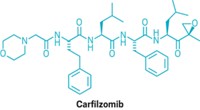Advertisement
Grab your lab coat. Let's get started
Welcome!
Welcome!
Create an account below to get 6 C&EN articles per month, receive newsletters and more - all free.
It seems this is your first time logging in online. Please enter the following information to continue.
As an ACS member you automatically get access to this site. All we need is few more details to create your reading experience.
Not you? Sign in with a different account.
Not you? Sign in with a different account.
ERROR 1
ERROR 1
ERROR 2
ERROR 2
ERROR 2
ERROR 2
ERROR 2
Password and Confirm password must match.
If you have an ACS member number, please enter it here so we can link this account to your membership. (optional)
ERROR 2
ACS values your privacy. By submitting your information, you are gaining access to C&EN and subscribing to our weekly newsletter. We use the information you provide to make your reading experience better, and we will never sell your data to third party members.
Pharmaceuticals
Drugs For Rare Diseases
Patient advocate finds orphan drugs are key to pharma's future
by Linda R. Raber
June 19, 2006

In the preamble to the 1983 Orphan Drug Act, Congress noted that many diseases and conditions, such as Huntington's disease, myoclonus, amyotrophic lateral sclerosis (ALS or Lou Gehrig's disease), Tourette's syndrome, and muscular dystrophy, affect such small numbers of individuals that they are considered rare. Congress continued, "Adequate drugs for many of such diseases and conditions have not been developed, [and] drugs for these diseases and conditions are commonly referred to as 'orphan drugs.' " The Orphan Drug Act provides substantial financial incentives for companies to develop drugs that are needed by fewer than 200,000 people in the U.S. at any one time.
Bringing these conditions and their treatments to the attention of lawmakers and advocating for people with rare disorders is Abbey S. Meyers, president of the National Organization for Rare Disorders (NORD). Meyers became a patient advocate in the early 1980s as a way of responding to her daughter's illness—Tourette's syndrome, a neurological disorder that had no treatment at the time—from which few people suffer. Meyers is considered the primary consumer advocate behind the passage of the orphan drug law.
Currently, approximately 6,000 rare disorders are on record, but only 285 approved orphan drugs are on the market. Meyers says there's a long way to go. An additional 1,400 investigational drugs remain in the pipeline. "Other countries, realizing how successful this has been, have passed their own orphan drug laws: first Japan, then Taiwan, then Europe in 2000," she says.
Meyers asserts that the biotechnology industry was built on the Orphan Drug Act and that attention to orphan conditions is essential for the industry's future. "Many biotech companies, even Amgen and Genentech, first got on the market with products that were orphan drugs," she says.
Some biotech drugs that were intended for smaller populations have found wider use. For example, she says, "erythropoietin was developed to treat anemia associated with kidney dialysis. It has since received broader applications in dealing with anemia that results from some cancer chemotherapies," she says.
Other drugs developed for rare disorders have become blockbusters through off-label use, that is, use for conditions that the drugs were not originally intended to treat. "Human growth hormone, which was developed by Genentech, was for 10,000 children with pituitary dwarfism. Once the drug was on the market, it was being prescribed for short children who did not have dwarfism," Meyers says.
But not all orphan drugs become blockbusters. "The major drawback is that for the true orphan drugs that really don't have off-label uses, the cost is very, very high," she says. She tells C&EN that the most expensive drug on the market is Genzyme's enzyme replacement for Gaucher's disease.
According to the National Institutes of Health's website, Gaucher's disease is an inherited metabolic disorder characterized by the accumulation of harmful quantities of a fatty substance called glucocerebroside in the spleen, liver, lungs, bone marrow, and sometimes the brain. Among three types of the Gaucher disease, the first, called type 1, is the most common. Patients bruise easily and experience fatigue due to anemia and low levels of blood platelets. They also develop enlarged livers and spleens, skeletal disorders, and, in some instances, impaired lungs and kidneys.
"The drug, an enzyme, costs several hundred thousand dollars per year, and because Gaucher's is a chronic disease, patients need to take it for the rest of their lives," Meyers says. "This is problematic, but this is saving people's lives."
Meyers believes that the future of pharma is in personalized medicines that will mostly be orphan drugs. For example, she says, instead of finding a drug that works against all breast cancers, researchers will look at a specific genetic defect and try to connect it to the cancer. In the future, she believes, physicians will use the results of genetic tests in prescribing personalized treatments to patients diagnosed with a disease.
"The closest thing that we're coming to this now is the hypertension drug they just got out on the market targeted toward people of African American heritage," Meyers says. "I think there will be much more of this."



Join the conversation
Contact the reporter
Submit a Letter to the Editor for publication
Engage with us on Twitter